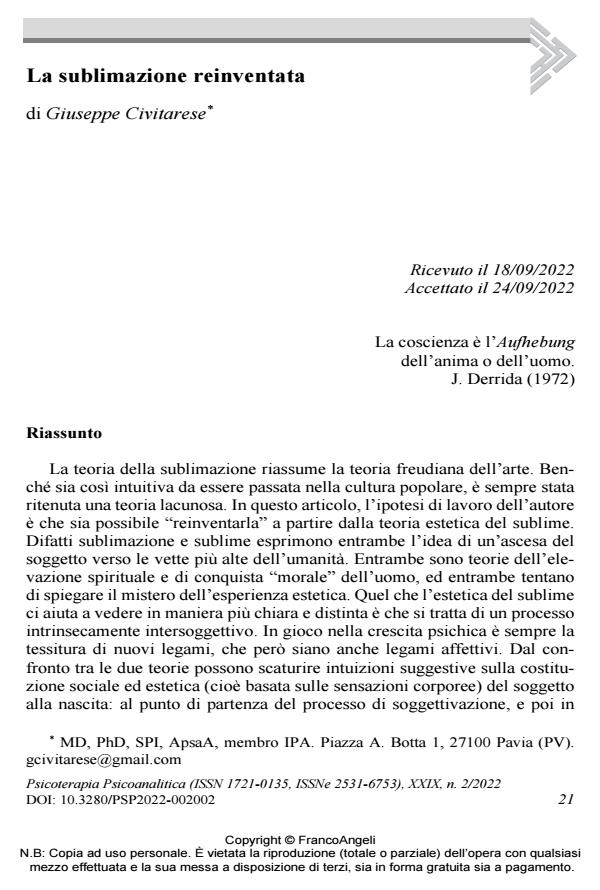Reinvented sublimation
Journal title PSICOTERAPIA PSICOANALITICA
Author/s Giuseppe Civitarese
Publishing Year 2022 Issue 2022/2
Language Italian Pages 23 P. 21-43 File size 246 KB
DOI 10.3280/PSP2022-002002
DOI is like a bar code for intellectual property: to have more infomation
click here
Below, you can see the article first page
If you want to buy this article in PDF format, you can do it, following the instructions to buy download credits

FrancoAngeli is member of Publishers International Linking Association, Inc (PILA), a not-for-profit association which run the CrossRef service enabling links to and from online scholarly content.
The theory of sublimation summarizes the Freudian theory of art. Although it is so intuitive that it has passed into popular culture, it has always been considered a weak theory. In this article, the author’s working hypothesis is that it is possible to "reinvent" it from the aes-thetic theory of the sublime. In fact, sublimation and sublime both ex-press the idea of the subject’s ascent to the highest peaks of humanity. Both are theories of man’s spiritual elevation and "moral" achievement, and both attempt to explain the mystery of aesthetic experience. What the aesthetics of the sublime helps us to see more clearly and distinctly is that it is an inherently intersubjective process. At stake in psychic growth is always the weaving of new bonds, which, however, are also affective bonds. Comparison of the two theories may yield sug-gestive insights into the social and aesthetic (i.e., based on bodily sen-sations) constitution of the subject at birth: at the starting point of the process of subjectivation, and then thereafter throughout life (one nev-er stops "being born"). Thus reinterpreted, the concept of sublimation, a metaphor Freud borrows from chemistry, where it designates the transition of a substance from solid to aeriform state, wonderfully points to the process of ascending from chaos to order, concrete to symbolic, body to spirit. The sublimation-as-reconciliation with the other, that takes place simultaneously on the plane of verbal thought and bodily intentionality, can then serve as a model of therapeutic action
Keywords: sublimation, sublime, intercorporeality, field theory, creativity, at-one-ment.
Giuseppe Civitarese, La sublimazione reinventata in "PSICOTERAPIA PSICOANALITICA" 2/2022, pp 21-43, DOI: 10.3280/PSP2022-002002